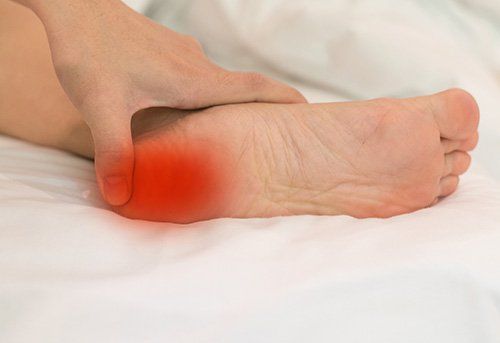Unveiling the Healing Power: Amniotic Stem Cell Therapy in Alleviating Heel Pain
Heel pain can be a debilitating condition that affects individuals of all ages, hindering daily activities and diminishing quality of life. For those seeking innovative and effective solutions, Dr. Etheridge and Pensacola Podiatry, PA, are at the forefront of a groundbreaking treatment – Amniotic Stem Cell Therapy. In this blog, we'll delve into the science behind this cutting-edge therapy and its role in treating heel pain.
Plantar fasciitis is an injury of the plantar fascial ligament that originates on the bottom surface of your heel bone. Symptoms are pretty specific with this condition. That is, one typically complains of pain after taking the first step. Sometimes this pain gets better as we "walk it out" but often it does not. As the condition progresses, most people begin to alter the way they walk.
How is it Diagnosed?
How Do We Treat Plantar Fasciitis?
What If My Self Treatment Does Not Work?
If after stretching, changing shoes, wearing a good insole and trying an oral anti-inflammatory you still have symptoms, a possible steroid injection may be administered followed by a functional plantar fascial taping. Surgery is rarely indicated for this condition.
The Science of Amniotic Stem Cells:
Amniotic stem cells are derived from the amniotic fluid surrounding a developing fetus during pregnancy. These cells possess remarkable regenerative properties, promoting tissue repair and reducing inflammation. Amniotic stem cells are rich in growth factors, cytokines, and other essential components that contribute to the healing process. Dr. Etheridge harnesses the power of these cells to address heel pain at its source.
Benefits of Amniotic Stem Cell Therapy for Heel Pain:
1. Regenerative Healing: Amniotic stem cells stimulate the regeneration of damaged tissues, promoting natural healing from within.
2. Anti-Inflammatory Properties: The therapy helps reduce inflammation, a key factor in many heel pain conditions.
3. Minimally Invasive: Unlike traditional surgical interventions, Amniotic Stem Cell Therapy is a minimally invasive procedure, minimizing downtime and discomfort.
4. Pain Relief: Patients often experience significant pain relief, allowing them to resume normal activities without the need for prolonged recovery.
Patient Testimonials:
"I never thought I'd find relief from the relentless heel pain that used to accompany every step I took. Thanks to Dr. Etheridge and the incredible team at Pensacola Podiatry, PA, my life has taken a 180-degree turn. Before discovering stem cell injections, hiking through the woods on hunting excursions was a distant memory. Plantar fasciitis had robbed me of the joy and freedom that comes with navigating nature for hours on end. Traditional treatments offered temporary relief, but the pain persisted. Enter Amniotic Stem Cell Therapy. Dr. Etheridge recommended this cutting-edge approach, and I can honestly say it's been nothing short of life-changing. The injections were quick and virtually painless, and the results were astounding. After a few weeks, I noticed a significant reduction in pain. Fast forward to today, and I find myself traversing the woods for hours, chasing my passion for hunting without a hint of discomfort. The stem cell injections have not just masked the pain; they've addressed the root cause, allowing me to reclaim the outdoor lifestyle I love. I am immensely grateful to Dr. Etheridge and Pensacola Podiatry, PA, for introducing me to this revolutionary treatment. If you're grappling with heel pain and it's holding you back from the activities you cherish, I wholeheartedly recommend exploring the possibilities of stem cell therapy. It's more than just a treatment; it's a restoration of the life you thought you'd lost." - David B
The Procedure:
Once you've decided to proceed with an Amniotic Stem Cell Injection, your foot will be numbed with a local anesthetic. Once the area is numb, Dr. Etheridge will utilize a musculoskeletal ultrasound to visualize the injured portion of your plantar fascia and then inject the area. You will be required to refrain any high impact activities for a period of 2-4 weeks.
FAQ's
1. How long does it take to start working and feeling better? While everyone heals at different rates, we typically see improvement in 2-3 weeks. The healing process continues over the next several weeks.
2. Is the procedure covered by insurance? Stem cell injection therapy is not covered by your insurance.
3. Cost: We charge $950.00 for one foot and $1600 for both feet.
Conclusion:
Dr. Etheridge and Pensacola Podiatry, PA, are pioneering a new era in the treatment of heel pain through Amniotic Stem Cell Therapy. As we witness the convergence of advanced medical science and regenerative medicine, individuals suffering from heel pain can find hope in a treatment that not only alleviates symptoms but addresses the root cause. If you or a loved one is seeking relief from heel pain, consider exploring the transformative possibilities offered by Amniotic Stem Cell Therapy at Pensacola Podiatry, PA.
Pensacola Podiatry, PA Blog



- Mon - Thu
- -
- Friday
- -
- Sat - Sun
- Closed
- Mon - Thu
- -
- Friday
- -
- Sat - Sun
- Closed
